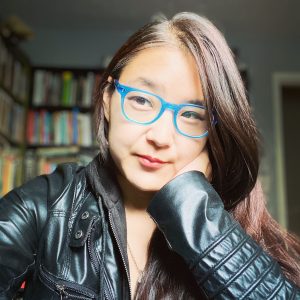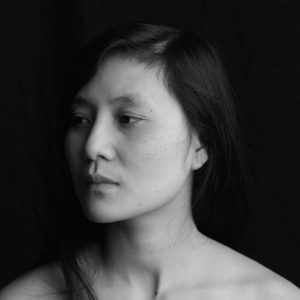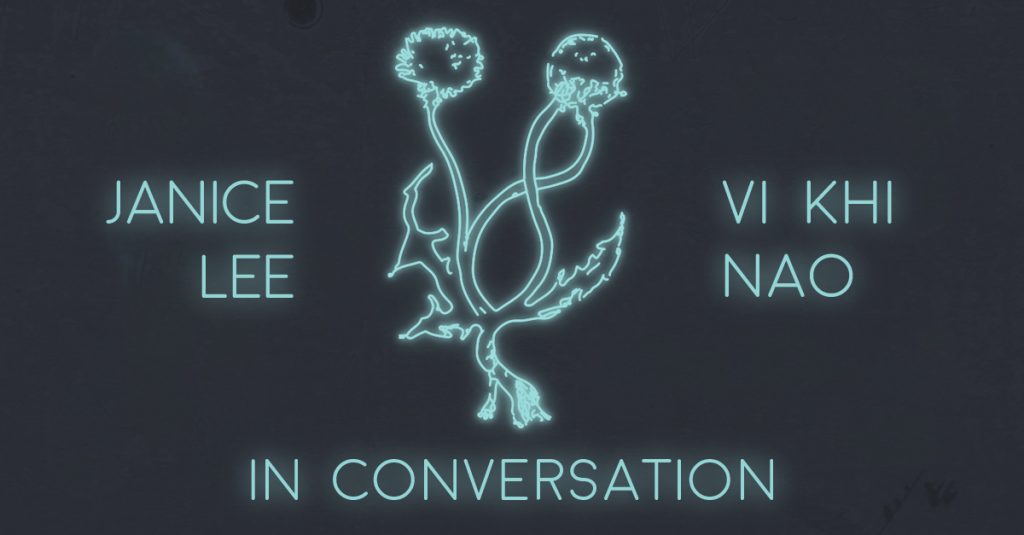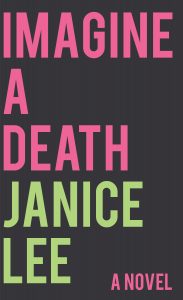 |  |
VI KHI NAO: I read the first half of your Imagine A Death during a flight into San Francisco. I am currently in Boulder—where I think the landscape ofthe high elevation may have altered my relationship with your work in the second half. Many of your sentences are long – like Bela Tarr long – and they require strong lung capacity to fully experience, inhale the depth and intensity of your gaze.
Being near this mountain, I feel I could acclimate to your long, gorgeous, beautiful sentences that open one world into another world into another world.
Has this long form (the long sentence) been a constant companion in your writing life—the one that you take long walks, long meandering with, the one whom you desire to stay faithful to or is it a decade obsession with an endpoint?
JANICE LEE: First, I’m grateful for your use of the word “acclimate” here. In thinking about landscapes, which are really important to me, I’m really thinking about climate. And climate not just in terms of the weather, but in terms of everything that is and has been and will be, everything that constitutes the space and the world, everything that unites us. So for me, the sentences are an extension of that kind of immersion in the world, in the entanglement of space. There isn’t just a body in a space, this rigid category between background and foreground, or external and internal, but where does the climate end and the body begin? I’ve always loved slowness and long takes. Bela Tarr, yes. I read Pasolini’s essay “Observations on the Long Take” in college and it changed the way I watched films and saw the world. But the long sentence as a form for me. I haven’t always written this way, no. I’ve definitely had long sentences here and there, but for a while, I was drawn to fragments. Long sentences, like fragments, are still an extension of expressing what can’t be articulated or encompassed in traditional sentence structures. What I love about long sentences is the ability to get lost, and I think this is important. The opportunity to get lost once in a while.
VKN: Do you think pain—in the tradition of length—is a type of slowness? When I study your sentences—your long sentences—& I go through this metaexperience (this slow, extended moment) where at the beginning I am an innocent, possibly naive person, and by the end of your sentence, I feel I have lived five cat lives. I am old and senescent—maybe in the way you have depicted the senescence of the tomato—Do you think long sentences like a camera with the widest lens possible—in either film or photography—are more technically capable of capturing pain—psychological or physical—better? Or do you think the fragments are equally or even more capable of capturing?
JL: That’s such an interesting question! Maybe pain, rather than a type of slowness, is a type of presence. I think about how trauma reconstitutes and reasserts itself in the present constantly, and how the present moment might be tethered to a moment in the past, or, become capable of expanding outwards. I think too about the difference between pain and suffering, at least from a Buddhist point of view. How do we let the pain in, how do we let it manifest? How can we acknowledge pain but not allow ourselves to become attached to it? I think that long sentences do capture a wider lens, the roving camera, so to speak, but it’s about the meandering, the letting go of a defined and linear trajectory, the reminder that no matter the length and windiness of the path, one can still arrive home. The long sentence also can encompass changing vantage points, the multiplicity within a single gaze, or multiple gazes that can exist simultaneously. Any departure from the standard sentence, whether it’s moving into the territory of unending sentences, or fragmentation, I think is about reaching towards a kind of articulation that doesn’t yet exist.
VKN: Do you think trauma can operate in the antipodes—delay the presence? A little. Or a lot. When I read the way you captured “trauma” in your work—I felt like a car going through a car wash. You are drawn to slowness and to length—n order to create and write Imagine A Death—did the interiority of your consciousness have to mimic your form? Or can you lead a fast and furious life and still produce work the opposite of your project’s vision?
JL: Ok, so I laughed out loud because The Fast and the Furious is one of my favorite film franchises. I’m interested in all the different kinds of inhabitation. I love being immersed, living in, sleeping in, dozing off in worlds like the films of Bela Tarr or Tsai Ming-Liang. I love to be reminded to slow down, to not treat time like a commodity. But I’m also a product of the ’90s and capitalism and action films and chaos cinema and I love the adrenaline rush that occurs inside the safety net of an action film like The Fast and the Furious where somehow, after all of the explosions, it’s still about family and returning home. But yes, trauma messes with time. It can delay, expand, protract, contract, blur, instigate. It’s a reminder that time isn’t linear or constant. I was thinking about what the long take does for me as a viewer, and how I experience the long sentences of Laszlo Krasznahorkai, but while writing, I also didn’t feel like I had a choice. It was as if the writing was almost channeled through me and poured out. The sentences didn’t want to end, couldn’t end, yet.
VKN: Yes, I read that in an interview of yours. Where Satantango and Fast and Furious co-exist in you—you quoted from Ufologist Jacques Vallee: “Mathematical theory often has to confront the fact that two contradictory theories can explain the same data. A solution is inevitably found not by choosing one of the contradictory theories, but by going to the next, third level.” Do you think Imagine A Death is your ontological or mathematical attempt at going to the third level? You were a pre-med major before pursuing biology and writing—had you continued in the medical life—do you think that Imagine A Death is a slow, frame by frame capture of you being a neurosurgeon placing trauma on the operating table, dissecting it second by second? Or is Imagine A Death a type of slow film or photograph in which you develop in the dark room of your imagination?
JL: In some ways Imagine a Death is a gesture of anti-colonialist sentimentality, in its narrative form and through the grammatical resistance of the long sentences, but it’s also about resisting colonial notions of the apocalypse and finality and redemption. This book felt like such a spiritual undertaking. In terms of the analogy with the medical life, Kerotakis and Daughter feel more like the neurosurgeon with a knife performing surgery. And Imagine a Death is more like the accidental but also utterly intentional slow film that was created because I left my camera on in my back pocket, or like those accidental iPhone pictures that capture more than you intend.
VKN: I mentioned pain in your work in relationship to the long sentences because of your compassionate, thorough, expansive consideration and contemplation in regards to apocalyptic suicide (your depiction of the suicidal pigeons) and apocalyptic rape (the pregnant goat that was gang-raped and eventually died). In your long sentences, you slowed down these moments—not just the moment where the writer was abused & revisiting that abuse (re-seeing a moment through a different, more acute lens, or replacing the camera/lens of that gaze with a broader, meta-lens,) and you process that grief (the loss of comprehension for inhumanity and brutality) for the readers. Do you think you can lend compassion to another who is lacking in compassion? Can writing/art/literature alter the empathic vernacular of a psychopath/an abusive person?
JL: Pain is a part of life, right, but how do we decide to exist in the world and in relation to other people despite or because of our pain? How do we desire to be free and imagine a kind of freedom beyond the causes and conditions of what currently bind us? The entanglement of grief and trauma and abuse and how our wounds shape our pasts and our futures—it’s all so complicated and difficult to look at, because it involves us having to look at the ways in which we have been complicit or complacent to or have perpetuated pain in the world, in response to the ways in which we have been harmed, or in the name of survival. Both of those incidents with the animals, and others in the book, I hated having to write them, but they are part of this world, and most importantly, they are part of us. When you ask about lending compassion to another, even if they’re lacking in compassion, I think the difficult answer is yes. We have to. We have to lend compassion to others (which, to clarify, isn’t the same as justification), and, we have to lend compassion for ourselves, which often is harder.
VKN: What are some of the challenges you face in writing a book of such a sophisticated caliber, Janice? And, were you able to resolve some of those challenges? Or are they life-long sorrows that you must revisit frequently by inducting a new birth/book into the world?
JL: Thanks for saying that, Vi. There are the constant challenges around articulation and the limitations of the structures in narrative and language. This book is especially important for me because it really does feel like it took a lifetime to write, the entirety of my being. I had to be open enough to be able to face all of my own demons in this way, and I had to write all of my other previous books to be able to understand myself in relation to language the way I do now. But it’s all ongoing. I feel very drained, but also relieved, after this book. It may be a while before I write another novel. There is some more breathing to do first.
VKN: What are some of your demons?
JL: My own fears and expectations around success, my doubts and grievances around what it means to be a writer, my feelings of inadequacy and self-worth, my processing of childhood wounds and relationship to my parents, the abusive relationships I’ve been in and my own unconscious complicity in perpetuating toxicity or harm, my own struggles with depression and suicidal impulses.
VKN: What is your definition of success? Also, there are 46 chapters in your Imagine A Death—do you have a favorite chapter? One you return to frequently because it captured something you were unable to capture for so long? One of my favorite moments (Chapter 20) is about a framed photograph dropped in a dumpster “miraculously” finding itself re-hung again in the same spot on the wall. There was something very tender and meta about this moment. How often we discard things because we believe others don’t value them or care as much as we do—but we are often wrong. People do care. I often think about sentences you have written—ones which you may cut down or deleted completely—and how another person may find tremendous value in their existence. Are there sentences you have erased that you feel deep sorrow for? Which sentences of yours should we re-hang? Also, how long does it take for you to write one of those long sentences? Ten minutes? An hour? How does the passage of time operate in the production part of your writing?
JL: I want to think of success, not as being about achievement or merit or legitimacy, but about desire and attempt and expression and existence. Rather than being tied to notions of good or bad, and rather than being seen in opposition to failure, why can’t success just be, not as a point of comparison or power over someone/something? Can’t failure be a kind of success? Can’t learning from a mistake be a kind of success? Can’t success be a gesture of reaching without turning into grasping, without becoming an attachment or way to measure us against each other?
I love that with the photograph moment as well, and it’s actually an example of a way that the novel started to influence the real world. That photograph is based on a real image (in real life, it’s a painting that my sister created when we were very young). She hates the painting but we had kept it because our mom loved it so much. The night after I wrote that scene in my manuscript, the actual painting fell off the wall and crashed onto the floor. It happened in the middle of the night; no one was around. We were all asleep and were awoken by the sound of breaking glass.
I don’t know if I have a favorite chapter in the book. Right now, I’m quite fond of “The Dream,” where everyone is burning alive, because it says something about death and intimacy for me.
I’ve deleted countless sentences, but I can’t remember them now. They will manifest again, I’m sure, in some other reincarnated form.
In writing this book, some of the sentences came out very quickly, over maybe 20-30 minutes, and some took more time, hours, or several writing sessions. I only listened to Russian Circles while writing this book, so something about the tension and momentum of that music helped me with rhythm, and helped me keep going.
VKN: A lot of your work that has arrived in this world exists in the capacity of fiction, though you also have a book of essays, a poetry book, etc. You operate on so many different levels—aesthetical strata—from being a graphic designer, professor, editor—how do you desire others to view or is it even possible to categorize your Imagine A Death? Is it experimental documentarism? Autofiction dressed like a bouquet of suicidal pigeons? If such a thing were to exist, what is an ideal way to pigeonhole you?
JL: As I’ve learned to articulate better, especially after hearing/reading writers like Renee Gladman and Matthew Salesses, the category or genre as a construct is important in terms of the expectations it creates, or dismisses, subverts, haunts, resists. And I am operating within certain expectations, but I also want to draw attention to the inadequacy or limitations of those expectations. In that vein, I do very much think of this as a “novel,” but one that hopefully expands on what a novel is “supposed” to be or look like. I love “autofiction dressed like a bouquet of suicidal pigeons,” though I don’t think Amazon accepts that as a genre category ☺
VKN: Also, what Korean film (to watch) and Korean dish—an appetizer perhaps or a gallimaufry of dishes—should be paired with your Imagine A Death? I love when wine is properly paired with food. And, I think of film as a type of wine.
JL: Oh my, such a difficult question because it’s so hard to choose. Okay. The Korean film would be Poetry directed by Lee Chang Dong.
And the Korean dish is one that I haven’t had yet before, but it’s appeared to me in my dreams and my ancestors are insisting that I need to eat it: Gwamaegi, which is a certain kind of dried fish.
VKN: Thank you for this beautiful pairing! I love dried fish and will have to try Gwamaegi when I re-read your book again with Poetry playing in the background. Many writers of Asian persuasion feel compelled to include Asian words or popular phrases or sentences or fragments or Asian language scripts in their work. Your Imagine A Death is mostly devoid of these ethnic gestures. I often feel that experimental writing allows one to be a devoted citizen of the weird, where experimentalism is a type of universal ethnicity. Do you feel at home in experimental writing? Where the textuality and materiality of the experience dominate the narrative mainframe of the literary?
JL: Such a good question. So at least in this book, I didn’t want the identities of characters to be specified. So I avoid those kinds of identity markers. But in terms of thinking of experimental writing more broadly, my relationship to it has changed throughout my life. In my earlier work, especially after my MFA, I was very drawn to “experimental writing” as a space to resist conventional forms and the canon, as a site for resistance and transgression. This also coincided with my politics at the time, which was much more about disruption and dismantling. At this particular point though, I’m thinking about things a little bit differently. It’s not just about resisting the dominant paradigm, because this then just re-centers the dominant narrative over and over again. Instead, I want to think about this as another worldview that is equally valid, another way to see and be in the world. So how might stories and sentences not only resist formal conventions, but also work against the myth of resolution and redemption, open up our biases around narrative and plot and character? How are our beliefs and assumptions around narrative structures and language related to our fears and beliefs about the state or ongoing future of the world?
VKN: Intimacy & vulnerability seem to be compelling materials for your work. What is the most intimate thing you have experienced lately, and how has it changed you as a writer?
JL: Okay, I was trying to think of something more sophisticated, but what’s popping into my head and is probably my most honest answer is doing psilocybin mushrooms with my boyfriend for the first time, when we literally melted into each other and became an amorphous blob. Doing mushrooms has also been a major portal for me, especially after the recent deaths of my dad and my dog Maggie, and has allowed me to speak with my ancestors and the dead, and the entire living world around me.
VKN: I am sorry to hear of your losses. Were you close to your dad? How han is your Imagine A Death? And, can you talk about your own visibility in the writing world? Outside of cinema and the camera lens, do you feel visible? If you have experienced a range of invisibility and now you are in the realm of visibility, what is an antidote to invisibility (in relation to politics and patriarchism?)
JL: Thank you so much, Vi. We were close in some ways, and so distant in others. He was living with me though, and he died at home in hospice. But the han, yes so much han, for sure. Probably in everything I write. There’s a point in the book where han is basically defined but not labeled as such. Also, your question about visibility is so important right, and so complex. As an Asian woman, how I’m perceived isn’t always up to me, but it affects how I’m seen, treated, valued, read. There is a kind of hyper-visibility or pre-judgment that erases much of who I really am, which isn’t as easy as just being invisible, and my own awareness or fears about how I’m perceived changes the way I operate in certain spaces. This is something I’m constantly struggling with, not being so attached to my identity or having to be seen in a certain way, letting go of aspects that I can’t control, and to try and just participate in more genuine encounters.
VKN: What is an example of a genuine encounter for you, Janice?
JL: Well, today I had a long and prolonged moment of eye contact with a squirrel who was eating the cucumbers in my garden.
VKN: That is so beautiful! In two days, your book enters the world! How will you celebrate its birth? I don’t want to hurt your other books’ feelings, but is Imagine A Death—is it a favorite of yours?
JL: It’s definitely the book that feels like it required all of my other books to write. So maybe not “favorite,” but for me personally, it does feel like the most significant. On Wednesday, I hope to eat something delicious (I don’t know what yet), have some kind of small ceremony around gratitude, abundance, and letting go, and will probably walk to the 7-11 to buy some scratchers!
VKN: One of my favorite Korean idioms is this idiom: 눈코 뜰 새 없다 (nun-ko tteul seh eupt-da)—“I don’t have time to open my eyes and nose.” What don’t you have time for? And, do you have a favorite Korean mantra/phrase/axiom? If you were to invent a Korean idiom, what would you invent? Also, this is non-sequitur, but one of my favorite long sentences of yours is: “and also she had come to see the sentence itself as a colonialist structure, and thought that perhaps these long sentences might be something she could give the reader, something they didn’t need but would receive anyways, like a gift, like listening, or something like it, and even in all of that gesturing towards a productive contemplation that might finally lead away from the past, she wondered if it was too late for her, if in fact because of everything she had already done, everyone she had already hurt, was it perhaps too late for us all?”
JL: Ha! That is a good one! I love the curtness of that idiom, how relevant it is, but it also reminds me of how we don’t have time for each other, for ourselves. I want to have more time for everything, especially for opening my eyes and nose. A phrase that’s always fascinated me because of how ridiculous it sounds is 파이팅! (pronounced “Pa-i-ting!”) which is derived from the English word “Fighting!” It’s like a cheer or term to encourage people, and the strange grammatical incongruence is so funny to me. A new one I just learned about yesterday thanks to @fluentkorean’s Instagram is this: 방귀가 잦으면 똥이 나온다 / “If farting becomes frequent, then the need to poop is imminent.”


